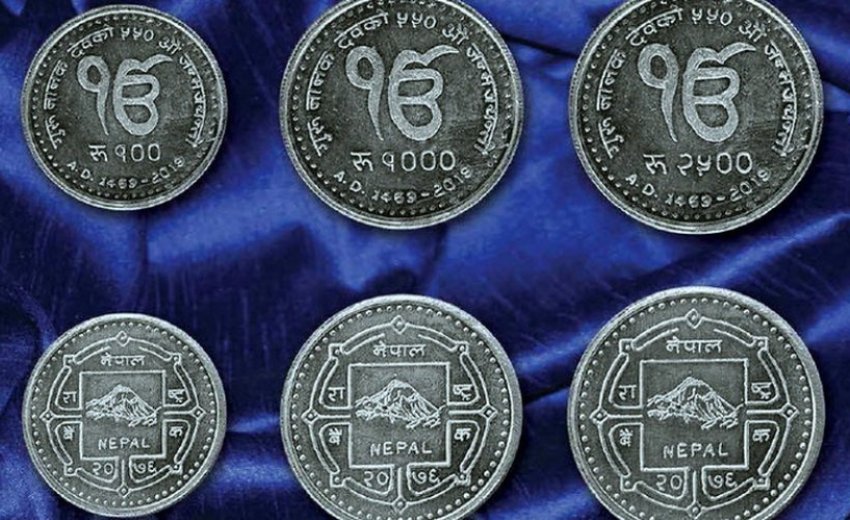Nepal has released three commemorative coins to mark the 550th birth anniversary of Guru Nanak, the founder of Sikhism and the first of the ten Sikh Gurus, who is said to have visited the Balaju area five hundred years ago. Dr. Chiranjibi Nepal, Governor of Nepal Central Bank, and Manjeev Singh Puri, Indian ambassador to Kathmandu, jointly released the coins.
All three coins bear the "Ek Onkar" (God is one) symbol on one side, and the edges are inscribed in Nepali with the words "550th birth anniversary of Guru Nanak." Nepal is one of only a few countries whose legal tender directly connects with Sikhs. To mark the 400th anniversary of the Guru Granth Sahib, the Nepal Rastra Bank also issued a coin with a value of NPR 250 in 2004. A "Khanda" and an image of Sri Guru Granth Sahib, the sacred text of the Sikh religion, are depicted on the coin.
SIKH HERITAGE IN NEPAL
Guru Nanak Dev Ji visited Nepal during his Udasis. He meditated under a peepal tree at Nanak Math in Balaju, Kathmandu. A Mahant presides over this temple, which appears to be the beneficiary of a huge land donation from the King. It is, however, largely unknown, and acclaimed novelist Desmond Doig referred to it as the "forgotten shrine of the Sikhs." Several handwritten copies of the Guru Granth Sahib are also found in Kathmandu which are related to the Udasi tradition. Kathmandu also boasts a few more shrines linked to the Udasi tradition. Guru Nanak Dev Ji's travels in Nepal are claimed to have included western Nepal, the Terai, Janakpur, places surrounding the Kosi River, and the Tengbuche Monastery in the Everest region.
In this regard, Dr. Dalvinder Singh Grewal has worked with one of the most famous mountaineers M.S Kohli, noting that Guru Nanak Dev Ji is revered in Tengbuche as Guru Rimpoche.
When Maharaja Ranjit Singh's armies battled inconclusively against Gorkha forces in Kangra, he established the Sikh link with Nepal. The Lahore Court recruited Gorkhas to serve in the Indian Army because of their heroism, and Nepalese are still referred to as 'Lahures' in the Indian Army. Maharani Jind Kaur the youngest wife of Maharaja Ranjit Singh, popularly known as Rani Jindan, escaped the British and moved to Nepal, where she lived for several years. A group of Sikhs accompanied Maharani Jind and eventually settled in Nepalgunj.
Sikhs in the Diaspora continue to retain their Sikh identity, including Gurdwaras in the villages of their concentration. The Sikh population in Nepal has made significant contributions to contemporary society, particularly as engineers, physicians, police officials, educators, pilots, and even fashion designers. In the 1970s and 1980s, over a thousand Sikhs were living in Nepal, and there was a large Gurudwara in Kupondole (Kathmandu), as well as smaller ones in Birgunj, Nepalgunj, Krishnanagar, and Butwal. Several Nepalese embraced Sikhism, such as Sardar Gurbaksh Singh.
Nepal became one of the few countries to issue legal tender that has a Sikh connection in 2004. A commemorative coin was released to mark the 400th anniversary of the founding of the Khalsa Panth. The Nepal Rastra Bank has released three coins in honor of Sri Guru Nanak Dev's 550th birthday: two in silver with the denomination of Nepali Rupees 2,500 and 1,000 and a cupronickel coin with a face value of Nepali Rupees 100.
A book titled Sikh Heritage of Nepal was also launched last month to coincide with the release of the coin. The book is authored by Manjeev Singh Puri, the Indian ambassador to Nepal. The book offers a historical analysis of Sikhism in Nepal, tracing its roots to the present day.
Although the Sikh population in Nepal is small, the historical and cultural ties it fosters are quite strong. The Sikh community in Nepal has aided in both the country's growth and the preservation of intercultural harmony. The 550th anniversary of Guru Nanak Dev Ji's birth provides a special reason for celebrating the Sikh heritage of Nepal.

